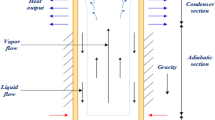Abstract
Concentric annular heat pipes (CAHP) were fabricated and tested to investigate their thermal characteristics. The CAHPs were 25.4 mm in outer diameter and 200 mm in length. The inner surface of the heat pipes was covered with screen mesh wicks and they were connected by four bridge wicks to provide liquid return path. Three different heat pipes were fabricated to observe the effect of change in diameter ratios between 2.31 and 4.23 while using the same outer tube dimensions. The major concern of this study was the transient response as well as isothermal characteristics of the heat pipe outer surface, considering the application as uniform heating device. A better performance was achieved as the diameter ratio increased. For the thermal load of 180 W, the maximum temperature difference on the outer surface in the axial direction of CAHP was 2.3°C while that of the copper block of the same outer dimension was 5.9°C. The minimum thermal resistance of the CAHP was measured to be 0.04°C/W. In regard to the transient response during start-up, the heat pipe showed almost no time lag to the heat source, while the copper block of the same outer dimensions exhibited about 25 min time lag.
Similar content being viewed by others
Abbreviations
- K :
-
Wick permeability (m2)
- L eff :
-
Effective heat pipe length (m)
- Δp f :
-
Pressure drop due to liquid friction (Pa)
- Q input :
-
Input thermal load (W)
- R d :
-
Diameter ratio: outer diameter of outer pipe / inner diameter of inner pipe
- R HP :
-
Thermal resistance of heat pipe (°C/W)
- γ c :
-
Capillary radius (m)
- \(\bar T_{evp} \) :
-
Average temperature of evaporator (°C)
- \(\bar T_{con} \) :
-
Average temperature of condenser (°C)
- \(\bar v_l \) :
-
Apparent liquid velocity through porous medium (m/s)
- μ l :
-
Liquid viscosity (N-s/m2)
- ρ l :
-
Liquid density (kg/m3)
- σ :
-
Surface tension of liquid (N/m)
- ø :
-
Fill charge ratio of working fluid(%): (charged liquid volume / total wick pore volume) × 100
References
Faghri, A. and Thomas, S., 1989, “Performance Characteristics of a Concentric Annular Heat Pipe:Part I-Experimental Prediction and Analysis of the Capillary Limit,”Journal of Heat Transfer, Vol. 111, No. 4, pp. 844–850.
Kim, K.S., Kim H. B. and Lee, K. W., 2003, “Development of Heat Pipe Heating Roller in Laser Printer,”Proceedings of The 7th International Heat Pipe Symposium, Jeju, Korea, pp. 65–69.
Kim. D. H., Park. S. Y. and Boo, J. H.. 2004, “A Study on the Thermal Performance of Concentric Annular Heat Pipes,”Proceedings of the KSME Spring Annual Meeting in Korea, pp. 1412–1417.
Peterson, G. P., 1994, An Introduction to Heat Pipes: Modeling, Testing, and Applications, John Wiley & Sons, Inc., pp. 1–7.
Vasiliev, L. L., 1973, “Heat and Mass Transfer in Low Temperature Heat Pipes,”Proceedings of The 1st International Heat Pipe Conference, Stuttgart, Germany, 3–1.
Author information
Authors and Affiliations
Corresponding author
Rights and permissions
About this article
Cite this article
Boo, J.H., Park, S.Y. & Kim, D.H. An experimental study on the thermal performance of a concentric annular heat pipe. J Mech Sci Technol 19, 1036–1043 (2005). https://doi.org/10.1007/BF02919187
Received:
Revised:
Issue Date:
DOI: https://doi.org/10.1007/BF02919187




